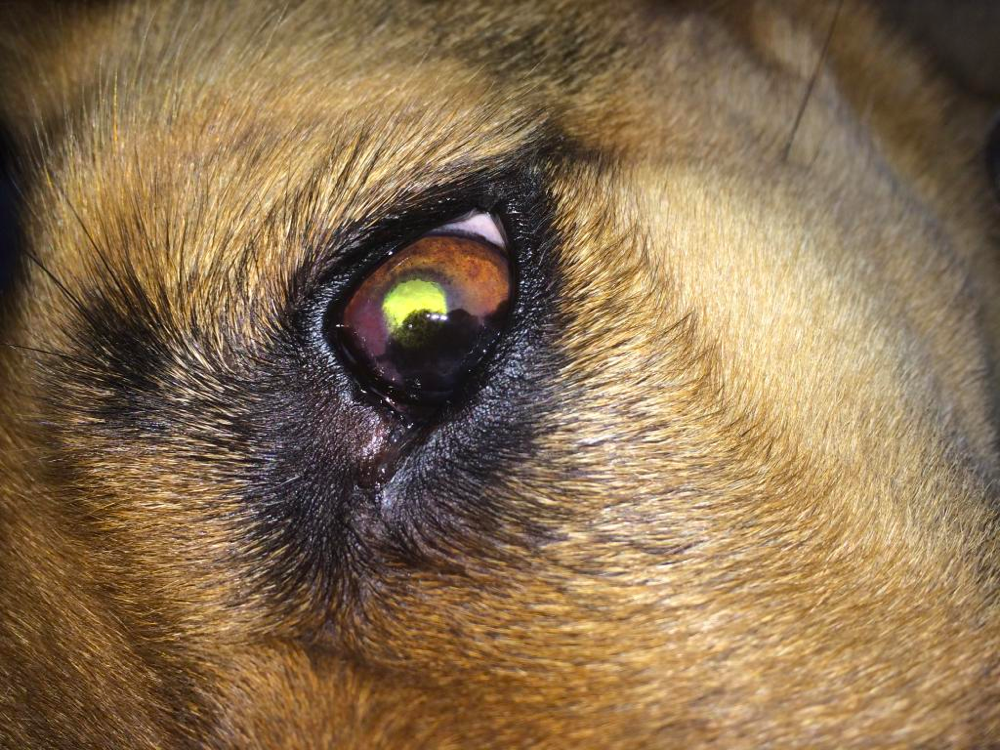Named after Keratitis Ueberreiter (a man who defined the disease), Dog Keratitis or Pannus happens to be a disease affecting the eyes of the animal. The dog suffers from chronic inflammation of the surface of the cornea. Even the conjunctiva is affected. In short, it is a painless, autoimmune disease in which both the cornea and conjunctiva face the brunt.
This eye disease is also dubbed German Shepherd Dog Keratitis because it is predominantly found in German Shepherd species. Poodles, Siberian Huskies, Belgian Tervuerens, Border Collies, Greyhounds, and Dachshunds are rarely affected by the same.
What Happens in Pannus?

The first appearance of Pannus happens in the outer regions of the cornea in both eyes (in major cases). The disease leads to the establishment of vascular granules and connective tissue in between the sclera and cornea – the growth takes place on the topmost layers of the cornea. This in turn results in the development of a cherry-colored spot that is opaque in nature and whose uneven surface is encircled by a fatty grayish-white band. With the progression of the disease, the cells responsible for pigment formation migrate from the outer layers toward the center of the cornea – the color of the spot ranges from grayish-pink to black and brown appearance. The inflammation comes along with the reddening of the conjunctiva. Actually, the dog suffers from a malfunctioning immune response to its own cornea, which gets manifested as pigmentation and scars.
What Causes Pannus?
Earlier it was thought that some infectious agents were in play. In recent days, Pannus is generally accepted to be the impairment of the immune system. At the onset of the disease, both endogenic and exogenic factors are responsible for causing the disease. Endogenic means something that is naturally produced by the body and in the case of this disease the endogenic factor is pinned to the inherent predisposition of the disease – but the hereditary factor is not yet fathomed properly by vet science. The external or exogenic factor that matters is the UV (Ultraviolet) rays of the sun. These harmful rays catalyze the onset of disease and it is a proven fact that Dog Keratitis or Pannus happens to affect dogs more in the summer months.
What’s the Treatment for Pannus?
If left untreated the inflammation will gradually spread to cover the entire surface of the cornea and the possible outcome might be complete blindness in the terminal stages. The pigment deposition is responsible for blurring the transparency of the cornea. Since Pannus affects both eyes, lack of veterinary care is sure to result in complete loss of eyesight.
The vet ensures to treat the active phases of the Pannus as fast as possible to prevent a severe outbreak and ultimate vision loss. They prescribe cortisone to suppress any kind of flare-up. If the disease is in its acute stage cortisone is administered via injections. But before the shot, the eye is anesthetized locally to avoid the feeling of pain.
Once you are back from the vet’s chamber you should continue cortisone therapy, combined with ointment application, on your pet. At least cortisone needs to be administered 4-5 times a day. There’s another medical treatment at your disposal. It is the topical application of an ointment called cyclosporin – this is effective for the long-term management of the disease. It depends on the vet to choose between corticosteroid and cyclosporine eye drops.
In extremely adverse cases, surgical removal of the top layer of the corneal surface is the best way out. But it should be kept at bay, unless a dire necessity. Last but not the least, a regular visit to the doctor is important to check factors that might trigger the onset of Pannus.
Avoid UV Rays

Ultraviolet rays are harmful and they trigger Pannus in German shepherds. So, if your pet is affected ensure that there is no such exposure. Avoid taking dogs out in the strong sun or snow glare. If the dog needs exercise it needs to be taken out on a stroll in the early hours of the morning. If you cannot avoid taking the animal out, you should protect the dog’s eyes with specially fitted sunglasses. Another way out is to administer a UV-blocking agent in the eyes. This needs to be reapplied at hourly intervals.

 Degenerative Myelopathy in German Shepherds: Symptoms, Causes and Treatment
Degenerative Myelopathy in German Shepherds: Symptoms, Causes and Treatment